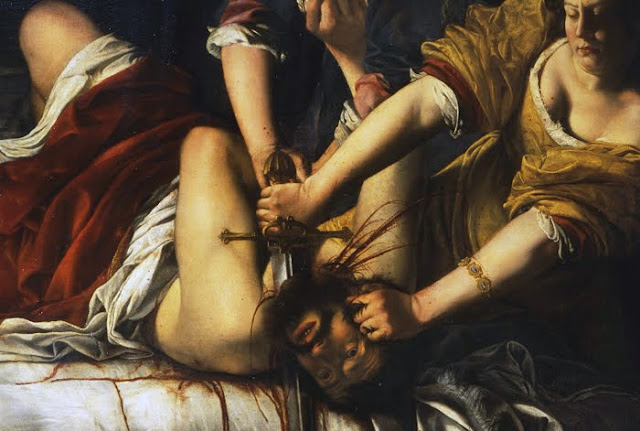Judith Slaying Holofernes (detail) by Artemisia Gentileschi, 1614–18
In the following artistic periods, you will see the realism that began in the Renaissance develop more fully until the staged, realistic style becomes codified by the Art Academies.
Baroque:
Roughly 1600-1750.
The Baroque style is often characterized by two stylistic trends: tenebrism and the "dramatic instant," although not all work from this period contains these things.
Tenebrism is the use of dramatic spotlighting to create emphasis in a scene. Tenebristic paintings have sharply lit focal points and dark backgrounds.
The "dramatic instant" refers to the moment right as all the action is happening. Baroque artists attempt to thrust the viewer into the scene, and one of the ways this is done is by depicting the scene mid-action (other methods include closely cropping the images and pushing the figures right to the edge of the picture plane).
Caravaggio is "the" Baroque painter, and is often credited with the tenebristic style.
Bernini is "the" Baroque sculptor, with his knack for drama and bringing us into the space of the artwork.
Khan Academy: Baroque Art in Europe (reading)
Khan Academy: Bernini, David (reading)
Khan Academy: Caravaggio, Deposition (reading)
Khan Academy: Caravaggio, Death of the Virgin (3:57)
Khan Academy: Gentileschi, Judith Slaying Holofernes (reading)
Rococo:
Roughly 1730-1780.
Some art historians group Rococo in with the Baroque, but there are notable differences. First, you will notice quite a shift in subject matter. Second, we have a geographic shift. Up through the Baroque, Italy has been the leading center of the art world. Beginning with the Rococo, France is going to rise up as the new art world trendsetter (and will remain so until the World Wars).
Rococo art is full of leisure, pleasure, and indulgence. It's pretty with florals and pastel colors. The architecture and decor is gilded and ornate. Art and fashion are closely connected. If you think of the aristocratic people of this time, powdered wigs, heavy blush, silk, and lace probably come to mind (for the men as well as the women). The same elements we think of in their appearance are reflected in the artwork they commissioned.
This is the artwork of pre-Revolutionary France (the time of Louis XVI and Marie Antoinette is at the tail end of the Rococo period), and it represents everything the revolutionaries came to despise.
Khan Academy: Fragonard, The Swing (reading)
Neoclassical:
Roughly 1760-1820
The Neoclassical movement is closely tied to the French Revolution. The artwork of this period called for a return to "morality" and strict gender roles. It was thought that the art (and politics) of the Rococo period had become too "feminized." If you think back to Fragonard's The Swing, the men and woman in that painting are treated pretty much the same. Look at David's Oath of the Horatii, however, and you will see upright, tan, muscular men, and sloped, lifeless, pale women. Much of the art of this time is political, but not all. We see a return of classical elements (hence, Neoclassical) in the form of classical architecture, clothing, mythology, and clarity. It often retains elements of the Baroque though as well, such as shallow spaces and dark backgrounds.
Khan Academy: Neoclassicism (reading)
Khan Academy: David, Oath of the Horatii (video - 6:10)
Academic Art:
Academic Art, as you can imagine, is artwork created in the style taught by the art academies, especially in France and England. Academic Art is realistic and smoothly painted. The genders are depicted in the style set forth by the Neoclassical painters - tan, muscular men and pale, soft women. The academies valued tradition and convention and looked down upon change and innovation. The highest praised subject matter according to the academy was "history painting," which includes historical scenes, mythological scenes, and biblical scenes.
Academic Art (reading)

